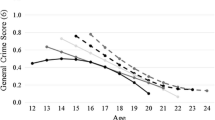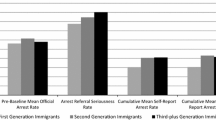Abstract
Both self-report and official crime data have known limitations, leading to the critical question as to whether inferences about the adolescent life-course of crime are different across these data sources. Using both official and self-report arrest data on a sample of subjects drawn from the Project on Human Development in Chicago Neighborhoods (PHDCN) longitudinal cohort study, this paper examines the extent to which individual age-arrest curves are comparable across these data sources. Particular attention is given to examining whether criminal career dimensions, namely participation, frequency of arrest, age of onset, and continuity in behavior, are similar across data sources. Additionally, this paper examines whether the key predictors of youth crime (e.g., family processes, peer influence, and neighborhood disadvantage) function similarly across measurement types. Findings reveal that a sizable number of youth self-report being arrested without having a corresponding official arrest record, and a sizable proportion of those youth with an official arrest record fail to self-report that they had been arrested. Despite significant differences across the two arrest measures on many criminal career dimensions, the effects of family supervision, parent–child conflict, and neighborhood disadvantage operate similarly across data types.


Similar content being viewed by others
Notes
All plots of age-arrest trajectories are constructed with fitted values from the Level-1 residual file in HLM.
References
Black D, Reiss AJ Jr (1970) Police control of juveniles. Am Soc Rev 35:63–77
Blumstein A, Cohen J, Roth JA, Visher CA (1986) Criminal careers and “career criminals”, vol I. National Academy Press, Washington, DC
Bradley RH, Corwyn RF, Caldwell BM, Whiteside-Mansell L, Wasserman GA, Mink IT (2000) Measuring the home environment of children in early adolescence. J Res Adolesc 10:247–288
Brame R, Bushway SD, Paternoster R, Thornberry TP (2005) Temporal linkages in violent and nonviolent criminal activity. J Quant Criminol 21:149–174
Browning CR, Leventhal T, Brooks-Gunn J (2004) Neighborhood context and racial differences in early adolescent sexual activity. Demography 41:697–720
Dunford FW, Elliott DS (1984) Identifying career offenders using self-reported data. J Res Crime Delinq 21:57–86
Farrington DP, Jolliffe D, Hawkins JD, Catalano RF, Hill KG, Kosterman R (2003) Comparing delinquency careers in court records and self-reports. Criminology 41:933–958
Geerken MR (1994) Rap sheets in criminological research: considerations and caveats. J Quant Criminol 10:3–21
Glueck S, Glueck E (1950) Unraveling juvenile delinquency. Commonwealth Fund, New York
Hardt RH, Petersen-Hardt S (1977) On determining the quality of delinquency self-report method. J Res Crime Delinq 14:247–261
Hindelang MJ, Hirschi T, Weis JG (1979) Correlates of delinquency: the illusion of discrepancy between self-report and official measures. Am Sociol Rev 44:996–1014
Hindelang MJ, Hirschi T, Weis JG (1981) Measuring delinquency. Sage Publications, Beverly Hills, CA
Hirschi T (1969) Causes of delinquency. University of California Press, Berkeley, CA
Horton NJ, Fitzmaurice GM (2004) Regression analysis of multiple source and multiple informant data from complex survey samples. Stat Med 23:2911–2933
Huizinga D, Elliott DS (1986) Reassessing the reliability and validity of self-report delinquent measures. J Quant Criminol 2:293–327
Illinois Criminal Justice Information Authority (2005) Comparing key parts of the Juvenile Justice Reform Act of 1998 with the Previous Illinois Law. Illinois Criminal Justice Information Authority, Chicago. Retrieved March 15, 2005 (www.icjia.org/public).
Kazemian L, Farrington DP (2005) Comparing the validity of prospective, retrospective, and official onset for different offending categories. J Quant Criminol 21:127–147
Kuo M, Mohler B, Raudenbush SW, Earls FJ (2000) Assessing exposure to violence using multiple informants: application of hierarchical linear model. J Child Psychol Psychiat 41:1049–1056
Laub JH, Sampson RJ (2003) Shared beginnings, divergent lives: delinquent boys to age 70. Harvard University Press, Cambridge, MA
Loeber R, Farrington DP, Petuchuk D (2003) Child delinquency: early intervention and prevention. Child Delinquency Bulletin Series, Office of Juvenile Justice and Delinquency Prevention, Washington, DC
Loeber R, Stouthamer-Loeber M (1986) Family factors as correlates and predictors of juvenile conduct problems and delinquency. In: Tonry M, Morris N (eds) Crime and justice, vol. 7. University of Chicago Press, Chicago, IL
Maxfield MG, Weiler BL, Widom CS (2000) Comparing self-reports and official records of arrests. J Quant Criminol 16:87–110
McCord J (1978) A thirty-year follow-up of treatment effects. Am Psychol 33:284–289
McNulty TL, Bellair PE (2003) Explaining racial and ethnic differences in serious adolescent violent behavior. Criminology 41:709–746
Moffitt TE (1993) Adolescence-limited and life-course-persistent antisocial behavior: A developmental taxonomy. Psychol Rev 100:674–701
Moffitt TE, Caspi A, Rutter M, Silva PA (2001) Sex differences in antisocial behaviour. Cambridge University Press, Cambridge, England
Myers SM (2002) Police encounters with juvenile suspects: explaining the use of authority and the provision of support, Final report submitted to the National Institute of Justice, Washington, DC
Nagin DS, Land KC (1993) Age, criminal careers, and population heterogeneity: specification and estimation of a nonparametric, mixed poisson model. Criminology 31:327–362
National Research Council and Institute of Medicine (2001). Juvenile crime, Juvenile justice. National Academy Press, Washington, DC
Piquero AR, Farrington DP, Blumstein A (2003) The criminal career paradigm. In: Tonry M (ed) Crime and justice, vol. 30. University of Chicago Press, Chicago, IL
Rabe-Hesketh S, Skrondal A, Pickles A (2004) GLLAMM manual, U.C. Berkeley Division of Biostatistics Working Paper Series, Berkeley, CA.
Sampson RJ, Laub JH (1993) Crime in the making: pathways and turning points through life. Harvard University Press, Cambridge, MA
Sampson RJ, Morenoff JD, Raudenbush SW (2005) Social anatomy of racial and ethnic disparities in violence. Am J Publ Health 95:224–232
Sampson RJ, Raudenbush SW, Earls F (1997) Neighborhoods and violent crime: a multilevel study of collective efficacy. Science 227:918–924
Shaw C, McKay H (1942) Juvenile delinquency and urban areas. University of Chicago Press, Chicago, IL
Short JF Jr, Nye FI (1957) Reported behavior as a criterion of deviant behavior. Social Problems 5:207–213
Short JF Jr, Nye FI (1958) Extent of unrecorded juvenile delinquency: tentative conclusions. J Crim Law Criminol 49:296–302
Straus M (1979) Measuring intrafamily conflict and violence: the conflict tactics (CT) scales. J Marriage Family 41:75–88
Sutherland EH (1947) Principles of criminology, 4th edn. J. B. Lippincott Co., Philadelphia, PA
Thornberry TP, Krohn MD (2000) Self-report method for measuring delinquency and crime. In: Duffee D (ed) Measurement and analysis of crime and justice. National Institute of Justice, Rockville, MD
Thornberry TP, Krohn MD (2003) Comparison of self-report and official data for measuring crime. In: National Research Council (ed) Measurement Issues in Criminal Justice Research: Workshop Summary, National Academy Press, Washington, DC
Warr M (1993) Age, peers, and delinquency. Criminology 31:17–40
Wilson WJ (1987) The truly disadvantaged: the inner city, the underclass, and public policy. University of Chicago Press, Chicago, IL
Wolfgang ME, Figlio RM, Sellin T (1972) Delinquency in a birth cohort. University of Chicago Press, Chicago, IL
Worden RE, Myers SM (1999) Police encounters with juvenile suspects, Report to the National Research Council’s Panel of Juvenile crime: prevention, treatment, and control. Washington, DC
Acknowledgments
This research was supported in part by Grant 2004-IJ-CX-0012 from the National Institute of Justice, by National Science Foundation grant SES-021551 to the National Consortium on Violence Research (NCOVR), and by the Henry A. Murray Dissertation Award from the Radcliffe Institute for Advanced Study at Harvard University. The Project on Human Development in Chicago Neighborhoods was conducted with support of the John D. and Catherine T. MacArthur Foundation, the National Institute of Justice and the National Institute of Mental Health. I thank Robert Goerge and John Dilts for their assistance in obtaining and processing the official arrest data used in this study. I also thank Andrew Abbott, Wayne Osgood, Andrew Papachristos, Paul Rathouz, Rob Sampson, and the anonymous reviewers for helpful comments on earlier drafts of this manuscript. Any findings or conclusions expressed are those solely of the author.
Author information
Authors and Affiliations
Corresponding author
Rights and permissions
About this article
Cite this article
Kirk, D.S. Examining the Divergence Across Self-report and Official Data Sources on Inferences About the Adolescent Life-course of Crime. J Quant Criminol 22, 107–129 (2006). https://doi.org/10.1007/s10940-006-9004-0
Published:
Issue Date:
DOI: https://doi.org/10.1007/s10940-006-9004-0




